A while back, a SaaS client approached us about their content marketing and lead generation strategy.
They recently launched their blog and already written some great content, but they weren’t getting any traffic. They’d discovered that great content isn’t enough to drive sales and conversions–and started looking for a better solution.
They discovered our story: Scaling a startup from 0 to 100k/mo organic.
So, they reached out.
Before sending the email, this client had a few calls with other content marketing agencies — all of which promised them the moon, predictably backed up by chart after chart of hockey stick growth.
Here’s the catch: The charts showed traffic growth, not conversions.
Now, to be fair, traffic can be an important KPI for some SaaS lead generation strategies. But not on its own. And many agencies use it as a sleight-of-hand tactic to focus your attention on one metric while they conveniently ignore the ones that matter more.
Traffic without conversions is just vanity.
I’ve seen this scenario play out hundreds of times throughout my career.
In fact, when I worked for another agency in my past life, this was exactly what was sold to clients. They’d pump up some big numbers and put together a graph that looked good, but it was completely hollow.
The “growth” was inflated or imagined—just clever wizardry in a spreadsheet.
Here’s the truth: It’s really easy to drive traffic to a blog post.
Take a look at the increase in this client’s traffic after we started working with them:

It looks impressive, right?
Here’s a harder truth: It’s much, much harder to consistently generate relevant traffic that converts into SaaS leads, users, and revenue.
This is something a lot of content agencies gloss over.
But, traffic without conversions is just vanity.
In order to convert casual browsers into leads, you need a holistic content strategy that takes the entire customer journey into account. You need to meet buyers at each stage of the funnel and move them closer to a conversion.
You need a content funnel that directly addresses the user’s problem and qualifies their interest in a solution.
Enter Optimist:

Yes, we were able to help this client grow their traffic significantly (to the tune of about 254% in just 5 months).
But, more importantly, in that same month period, we saw a 571% uptick in leads for the SaaS product.
Admittedly, we don’t—and can’t—own our client’s entire sales funnel. There are just way too many variables that are out of our control and out of scope for the work that we do.
But we are partners with our clients—truly.
Our success as a business depends on our ability to help our clients succeed. We’re invested in doing everything we can to not only help clients generate traffic or engagement, but to actually translate that activity into business growth.
Let’s Talk About Growing Your SaaS Leads & Sales
Book a strategy call with our team to discuss how we can help you hit your growth goals.
This means our approach to content marketing must support the ultimate business goals of the organization.
That is, our strategy must align driving traffic with a steady climb in leads, sign ups, or revenue.
Here’s how we did it.
SaaS Lead Generation with Content Marketing: A Strategy Overview
Once upon a time, SEO was simple.
And, frankly, the expectations were also extremely low. Just 5 or 10 years ago, the idea that you could publish your own content on your own website was still an emerging opportunity for many businesses.
But as the market has matured, competition has increased, and so has the sophistication of winning content marketing strategies. SaaS SEO isn’t rocket science–but it does require a focused strategy.
First of all, we already know that SEO has evolved way beyond the days of keyword spamming, cloaking, and footer links.
Secondly, the bar for content has risen. In the early days of online publishing and business blogs, a simple 500-word article could gain a lot of attention and traction. But now, readers expect high-quality, well-researched long-form content—and better quality content also performs better in search and on social channels. More than 80% of businesses say they have a content marketing strategy, which means that there’s more content than ever–and more competition for readers’ attention.
Lastly, simply getting people to click on your link or land on your website isn’t a viable strategy for generating actual sales and revenue.
You need a strategy beyond simply publishing content and racking up page views.
Many firms still do basic keyword research, throw together a calendar, and call it a strategy.
But, that’s not how you achieve growth.
In order to build a growth-focused content marketing strategy, you need to understand the various moving parts that go into driving the desired outcome.
Applying JTBD to Understand Buyer Needs and Pain Points
Any content marketing strategy should start by first defining the personas of the people you are trying to reach. These are your buyers.
In all likelihood, you’ll be targeting several different personas here.
But the key is to understand who you are reaching – for several reasons.
- This gives you insight into their pain points;
- Allows you to understand their specific use cases; and
- Enables you to create content that speaks to their specific needs.
But, simply documenting your personas isn’t enough to inform strategy. Sure, it gives you insights about who you’re addressing, but it doesn’t translate into actionable tactics that you can execute.
Successful products and services help customers solve problems and achieve their goals.
Whole generations of marketers and sales professionals have bent over backwards trying to find the best way to segment consumers according to demographic and psychographic data in an attempt to accurately isolate consumer needs and better influence their purchase behavior.
People don’t buy quarter-inch drill bits. They buy quarter-inch holes.
And to some extent, it’s worked. However, the Jobs To Be Done (JTBD) framework takes this idea a little further by identifying what target consumers really want to achieve – not just what they say they want.
The old adage goes that people don’t buy quarter-inch drill bits.
They buy quarter-inch holes.
In other words, they’re only buying the tool because they already have a specific need or goal in mind and recognize that the tool will achieve that outcome.
This is true for SaaS, too. Your software and all its features are ultimately tools that you’re selling in order to help your customers achieve their goals.
This is the basis for understanding and attracting top-of-the-funnel (TOFU) traffic that converts into leads.
Developing Top of the Funnel Content Marketing Strategy for SaaS Products
Many content strategies fall into the trap of focusing on broad segments without connecting the buyer goal to the business goal. The result is typically a blog full of content that addresses the right buyer, but doesn’t connect their needs to the solution.
We see this manifest in the form of “fluff” posts that drive traffic, but not leads.
Our team uses the JTBD framework to better understand each buyer persona and translate their needs and characteristics into an actionable plan.
We use the JTBD framework as a jumping-off point to identify and prioritize the keywords and content that both address the target buyer and connect their specific pain points to the product solution.
The JTBD approach examines the specific circumstances driving the consumer’s desire – or hesitation – to act. The aim is to understand all the moving parts influencing their decision and identify the job they’re really “hiring” the product to do.
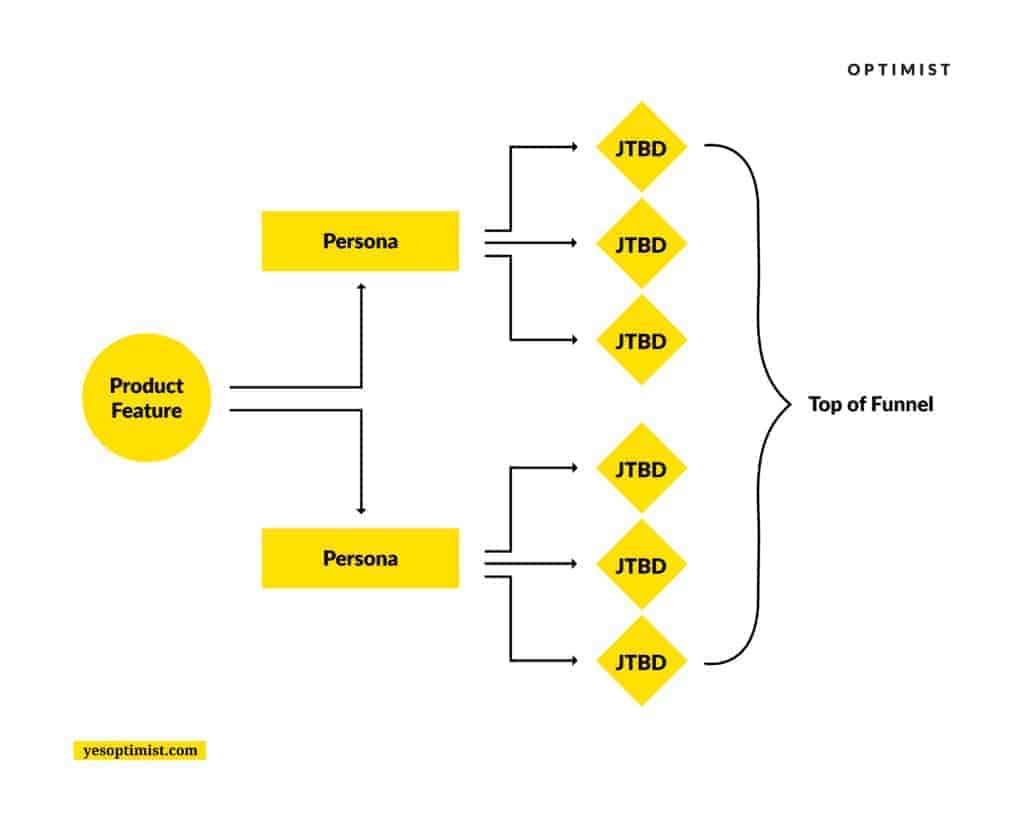
When it comes to using content marketing to generate leads, you can apply this framework to the top and middle of the funnel by breaking down the individual product features and use cases by persona. Then, further breaking down each persona’s buying motivations into specific Jobs to be Done.
So, what is the job your customers are hiring your SaaS product to do?
To answer this question, you need to start with a profile of your ideal customer(s), each specific feature, and then develop an idea of which problems that feature ultimately solves for them.
Consider the following questions:
- Who are the prospective buyers involved?
- Which product features would each persona be most interested in?
- What are their day-to-day pain points that can be solved by these features?
- If they were searching for a solution to this pain point, what language would they use?
- How does your product solve their specific pain point(s)?
The answers provide an itemized breakdown of the top of the funnel. In other words, we can understand the initial pain points (and related keywords) that prompt the buying journey (that is, we can see exactly where buyers enter the funnel).
For this client, the product was related to sales with features that would help companies generate more prospects for their sales funnel.
So, we mapped those features to specific JTBD for each type of buyer.
This gave us a pile of relevant topics and keywords related to the jobs to be done that led buyers to go looking for a solution:
- Generate more sales lead
- Automate sales prospecting
- Qualify more MQLs
- Scale sales ops
Each of these JTBD represented a problem that the buyer experienced that could be solved — at least, in part — by the client’s SaaS product.
Based on this, we were able to better understand the funnel starting point for many buyers and used this to inform the top of the funnel content we created to attract potential users early in their journey.
Converting Top of the Funnel Traffic Into SaaS Sales Leads
Here’s where most people get content marketing wrong.
They understand how to do keyword research. They write good content about relevant topics.
Hell, it might even rank and start generating traffic! Win!
But, they also assume that any traffic entering the top of the funnel will naturally lead to people discovering the product, understanding it, and then signing up. Or, at the very least, that some of that traffic will come back and read another post later, stay engaged, and sign up eventually.
For most companies, content marketing isn’t a branding strategy — it’s about acquisition.
Unfortunately, that’s rarely the case.
While a small percentage of readers might decide right then and there to try your product, the bulk of TOFU traffic just isn’t ready to buy yet.
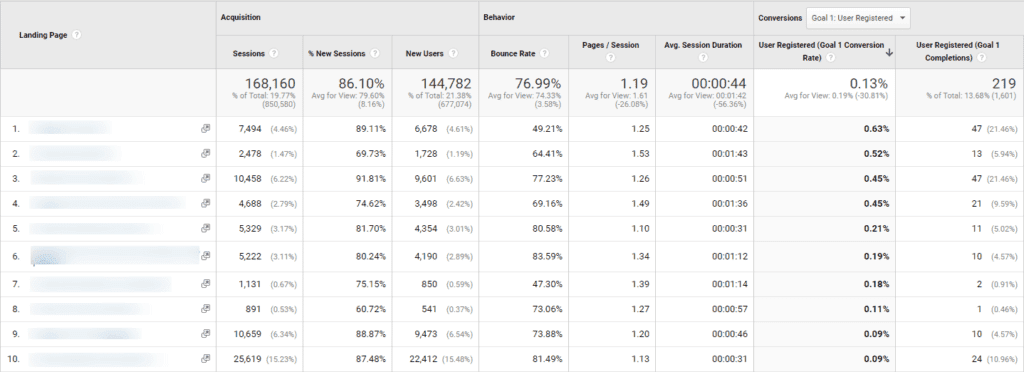
Simply put, top of the funnel conversion rates to product signups will be low.
This is by design and it’s to be expected. The role of top of the funnel content is to attract, qualify, and educate potential buyers. So it shouldn’t be surprising that the vast majority of those readers aren’t clicking “buy”.
But that doesn’t mean that we should just conclude that conversions won’t happen or leave it to chance.
For most companies, content marketing isn’t a branding strategy — it’s about acquisition.
What this means is that many companies try content marketing for a while, they see traffic without sign ups, and then conclude, “content marketing doesn’t work!”
Wrong.
The key to generating SaaS leads with content marketing is to think about the entire funnel.
SaaS lead generation shouldn’t be a passive activity.
You can’t expect a lot of customers to read a single blog post about how your product helps them solve a single problem and immediately whip out their credit card.
For this client, we built out from this top of the funnel content to maximize the business value of every visitor reading each post. In other words, we built a strategy for moving readers from prospects (targeted traffic) to leads (demonstrated need/fit).
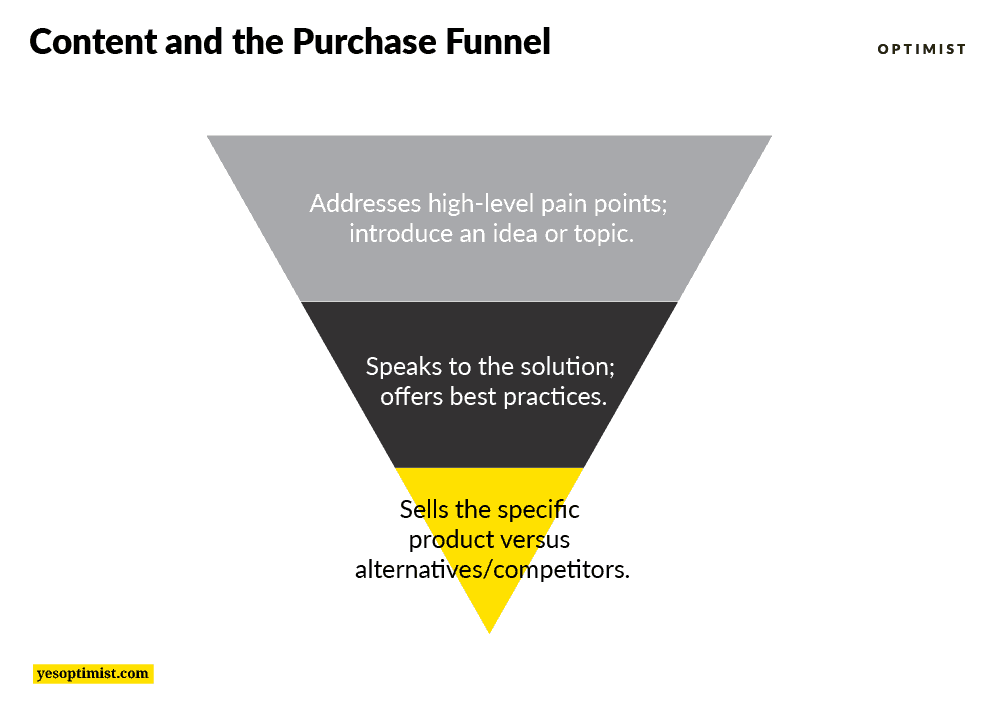
As content marketers, our job is to build a strategy that pulls readers through the funnel and drives them to sign up.
This means understanding the funnel from the perspective of the buyer and connecting each piece of content to a specific step or action designed to move them closer to a purchase.
This is why we need to think about the content we are creating in terms of its role in this buying process:
● Top of Funnel – Addresses high-level pain points; introduces an idea or topic.
● Middle of Funnel – Speaks to the solution; offers best practices.
● Bottom of Funnel – Sells the specific product versus alternatives/competitors.
From there, we can construct tailored journeys for readers, depending on where they begin the buying process, and send them down a path toward conversion.
Qualifying Leads with Gated Content that Signals Intent
Most marketers understand how the funnel works when it comes to generating leads from content.
Generating a contact is not the same thing as generating a lead.
The standard mechanism here is to offer readers some kind of downloadable guide or content upgrade (gated content) in exchange for an email address. In theory, this is how you move a casual reader at the top of the funnel into a qualified lead in the middle of the funnel.
This is another place where SaaS lead generation strategies can go awry.
So, here’s an important reminder:
Generating a contact is not the same thing as generating a lead.
A newsletter subscriber is not necessarily a potential customer in waiting. Someone who downloads a template for a product-adjacent task is not necessarily an MQL just because they gave you their email address.
In other words, the substance of your gated content is critical to success.
The content that you’re offering readers should accomplish two key goals:
- Generate a contact by enticing them to exchange their email for the content
- Signal the reader’s buying intent to qualify them as a lead
This means that not all content offers are created equal and the key to effectively generating leads at scale is to both tailor the offer closely to the content of each article and make sure the substance of that content is effective at signaling the contact’s buying intent for the product itself.
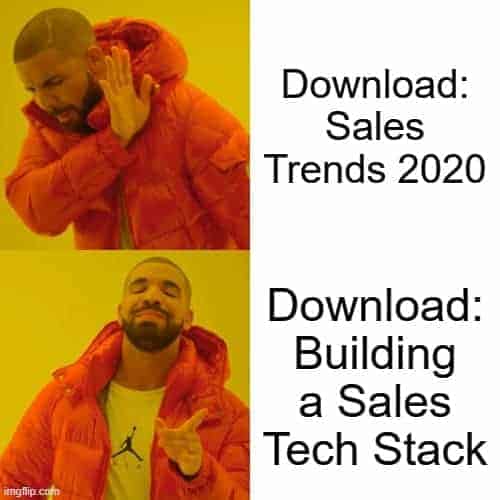
For this client, we developed tailored content offers for nearly every upper funnel post.
Following each download offer, we built a custom email and content nurturing sequence that addressed their needs and pain points based on the content they had already requested.
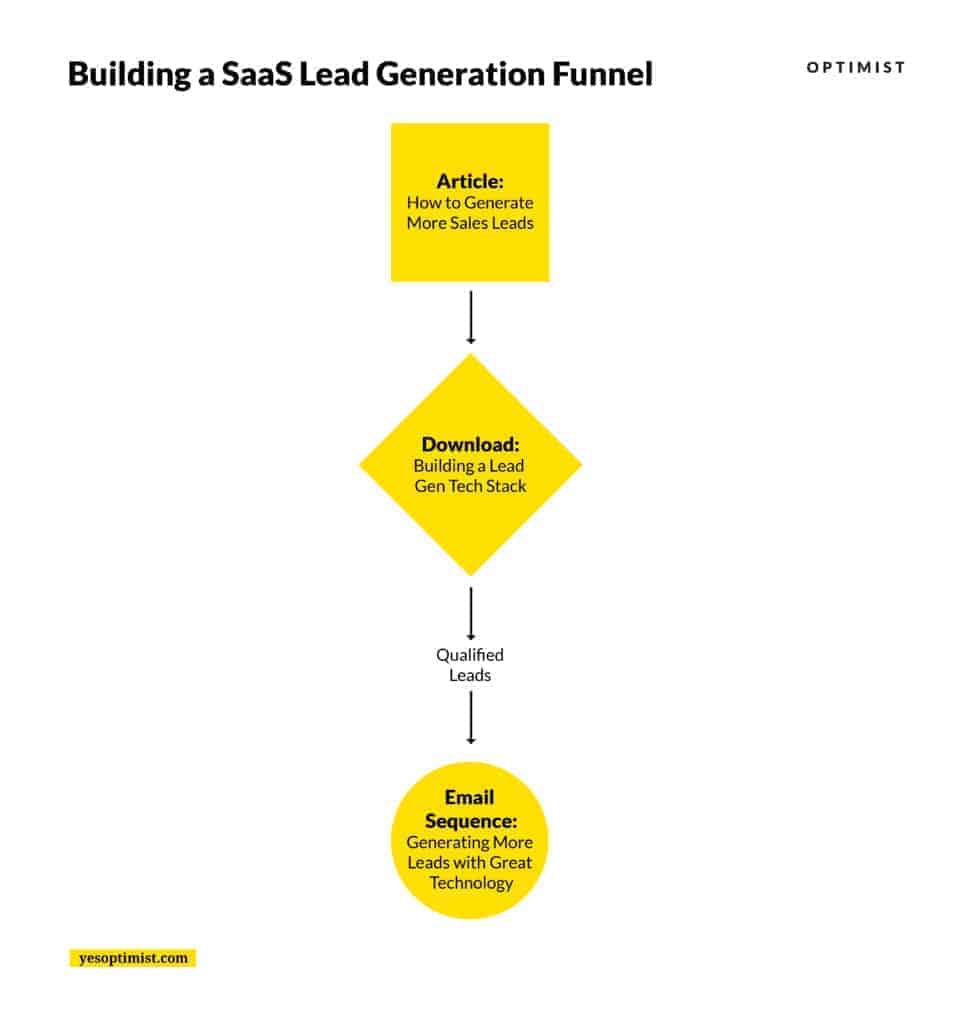
Again, we can see how the substance of the content is actually more important than simply capturing the contact. Based on the content offer itself, we can understand and target messaging.
We’re effectively allowing leads to both self-quality and self-segment, then using the data to build a smart nurturing strategy.
We know what this lead wants to accomplish. Now let’s help them do it.
The blog posts at the top of the funnel simply introduce the reader to the topic, educate them about the problem, and offer some potential solutions. To move leads through the funnel, these blogs should direct your reader’s attention to a helpful, more in-depth guide or ebook on the topic — thereby further qualifying their need.
The guide or ebook educates the prospective customer on how to achieve what they’re trying to do and gives you the opportunity to introduce your product as the ultimate solution.
Now you’ve got their attention and they’ve demonstrated a need for your product.
They’re aware that a solution to their problem exists. They just need some help realizing that your solution is exactly what they need. This is where the email sequence comes in, continuing to provide helpful content and offering a free trial or demo to convince the newly product-aware buyer to check out what you’re selling.
This is the SaaS lead generation roadmap we followed from the start.
Expanding the SaaS Funnel to Drive More Leads
Once we had a basic framework for how to convert traffic into leads, we were able to rapidly scale the strategy to expand the funnel and capture leads from multiple personas with various needs and pain points.
In practice, this involves taking the same strategy and applying it across the various JTBD that we identified early on, creating new middle-of-the-funnel content assets and email nurturing campaigns as needed.
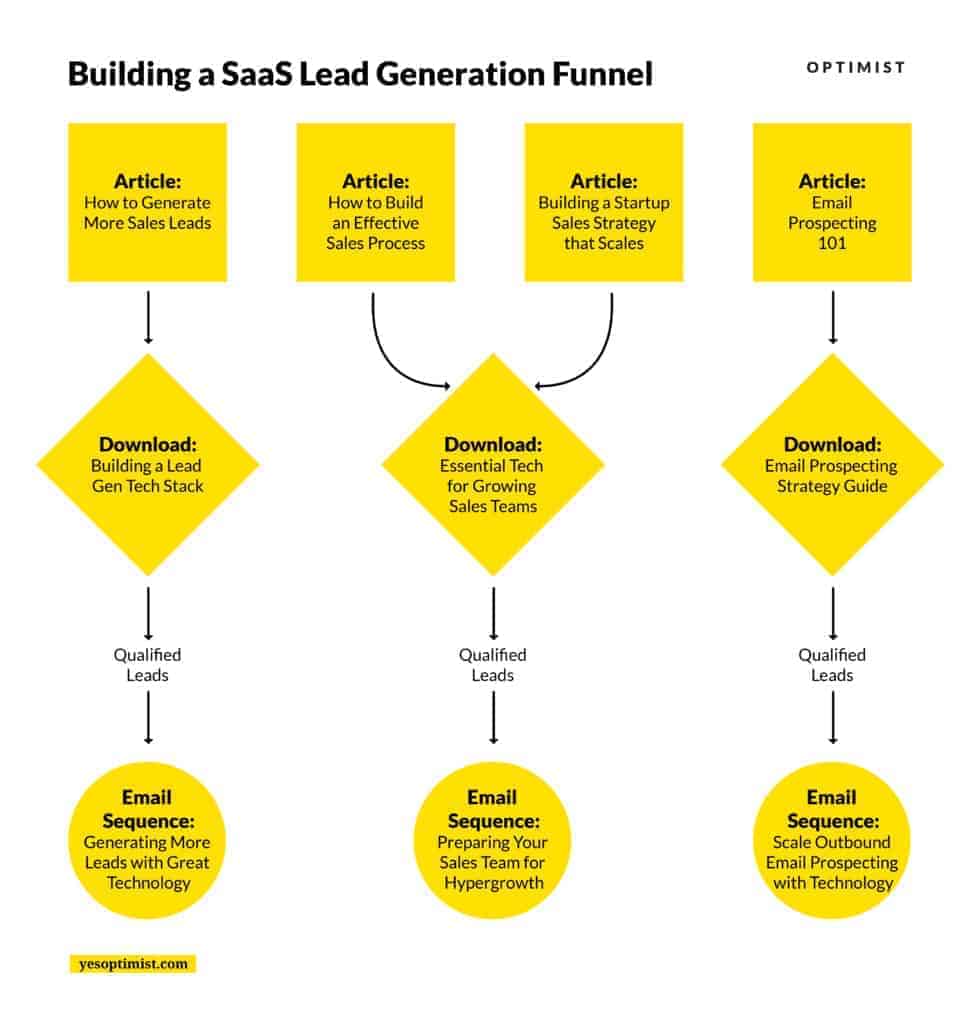
This means treating each piece of content as an entry point for a larger campaign that’s meant to generate traffic and leads.
We used this same framework over multiple personas and pain points to quickly stand up top-to-bottom content funnels that capture buyers and nurture them to sign up.
Moving SaaS Lead Generation Down-Funnel to Capture Existing Market Demand
What we’ve done up to this point assumes that the majority of buyers will come to your site when they’re at the beginning of their buying journey.
This JTBD strategy assumes there’s a clear path from initial discovery to actual signup.

Of course, the buyer’s journey isn’t always (or even usually) linear.
Sometimes, customers will discover your product when they’re already most of the way through their journey. Perhaps they begin their journey already understanding their problem and the potential solutions that exist. Some buyers may even already know the products that solve their problems (or use them!) and they’re looking for alternative solutions.
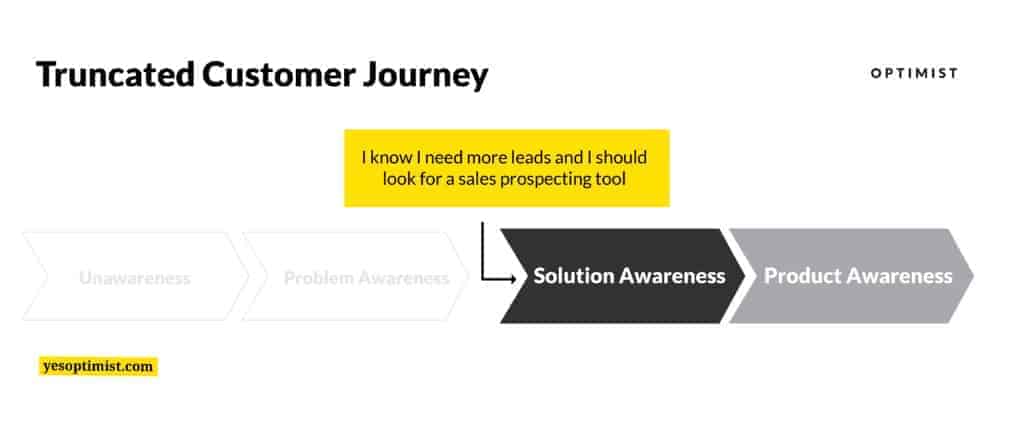
Whatever the case may be, there are many viable buyer’s journeys and focusing on capturing leads at the top of the funnel is just one strategy that works here.
For this client, we also moved down the funnel to create content and pages that would rank for product- and solution-specific keywords, capturing existing demand.
These buyers are closer to a purchase decision.
So, this traffic is more likely to convert directly into a product signup or free trial.

But how do we actually capture traffic from these high-intent buyers?
We follow a content marketing strategy that works particularly well for SaaS lead generation. It involves a combination of product-focused blog content, product marketing pages, and competitor comparisons.
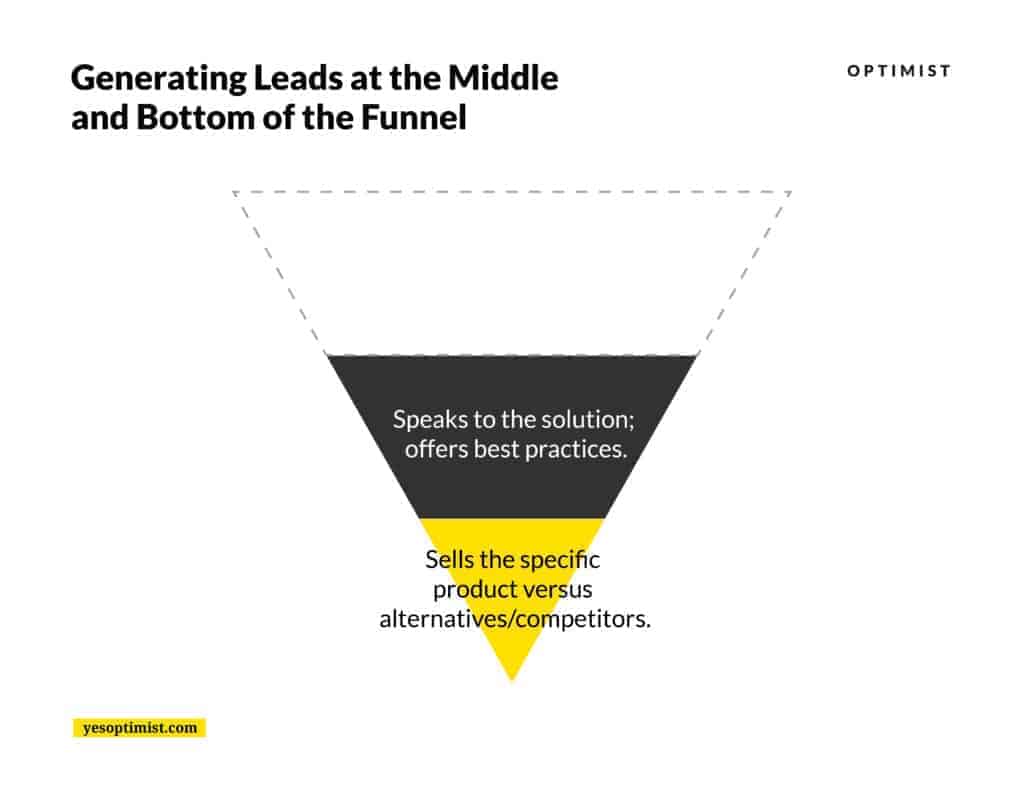
Rather than focusing on problem-specific keywords tied to JTBD, the middle and the bottom of the funnel are focused on solution- and product-specific keywords and content.
So, at this stage, we assume that the buyer already understands their problem (“I need to generate more leads”) and they’re now looking for a specific solution.
How do they discover relevant solutions to this problem?
In the most basic scenario, they simply head to Google and start their search.
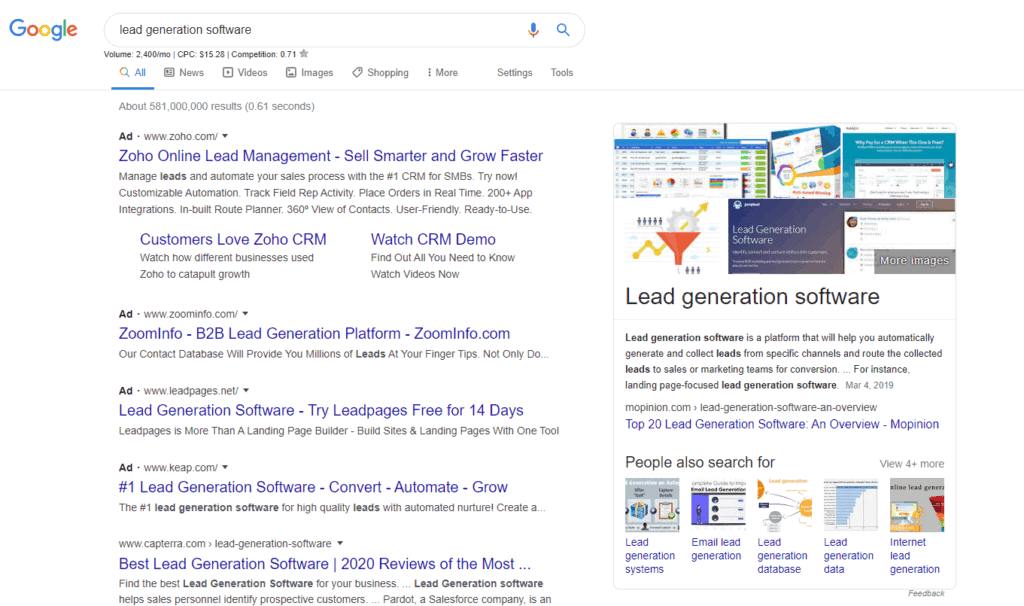
In our SEO for SaaS framework, we identify six key types of keywords and content in the middle of the funnel:
- Product category – Your most basic searches, like “lead generation software”
- Product category comparison – When the buyer is comparing multiple possible solutions to their initial pain. (“Prospecting software vs landing page software”)
- Solution/industry – More specific searches that identify the buyer’s persona or industry. (“B2B prospecting software”)
- Features – Specific features that the user is looking for in a solution. (“Email automation prospecting software”)
- Integrations – How the software plugs into other tools. (“Prospecting software for Gmail”)
- Implementations – Specific use cases that the user is researching. (“Lead prospecting in Gmail”)
From an SEO standpoint, this content will help you capture existing demand.
In other words, your goal here is to get in front of buyers when they are in the middle and final stages of their journey.
Keep in mind that this content is acquisition-driven. It’s about generating relevant traffic and leads through search and social channels.
Traditional middle- and bottom-of-the-funnel content includes items like case studies, product documentation, integration use cases, and other nurturing content. In our strategy, we also developed this kind of content as part of our nurturing strategy — and some of these assets can also be used to drive acquisition.
The key to scaling the strategy here is to build a broad and actionable plan to capture as much existing demand as possible with optimized posts and pages. In order to do this, we circled back to our keyword research process and approached it in a different way.
We itemized each of the product features, integrations, target industries, and competitors.
Then, we used Ahrefs to uncover the most relevant priority keywords at the middle and bottom of the funnel.

Using this, we built a new piece of the strategy that focused on expanding the search footprint of the website and ranking for a broad set of keywords deeper into the buyer’s journey.
From there, we were able to increase traffic to these high-intent pages by nearly 400% and drive an associated uptick in signups. As time goes on, we expect that these pages will grow with improved domain authority, ranking higher and generating more traffic.
Note that we could have started our strategy here. And many content marketers will, in fact, begin their strategy at the bottom of the funnel because of the high intent associated with these keywords.
But, the reality is that most sites won’t be able to rank for these competitive keywords unless they already have an established and authoritative domain. We chose to start at the top of the funnel to build momentum — and links — that we could parlay into more traffic and conversions as the site grew.
This brings us to the final part of the strategy (and the backbone that drove rankings and traffic) — strategic linkbuilding.
Building Authority to Rank Throughout the Funnel
The final piece of our SaaS lead generation strategy is one that’s all too often ignored or left up to chance.
That’s linkbuilding.
Building links and increasing your site’s authority is an absolutely critical component to any search-driven growth strategy. Plainly put, without links your content is not likely to rank well in search engines and you’ll never generate the traffic you need to drive growth.
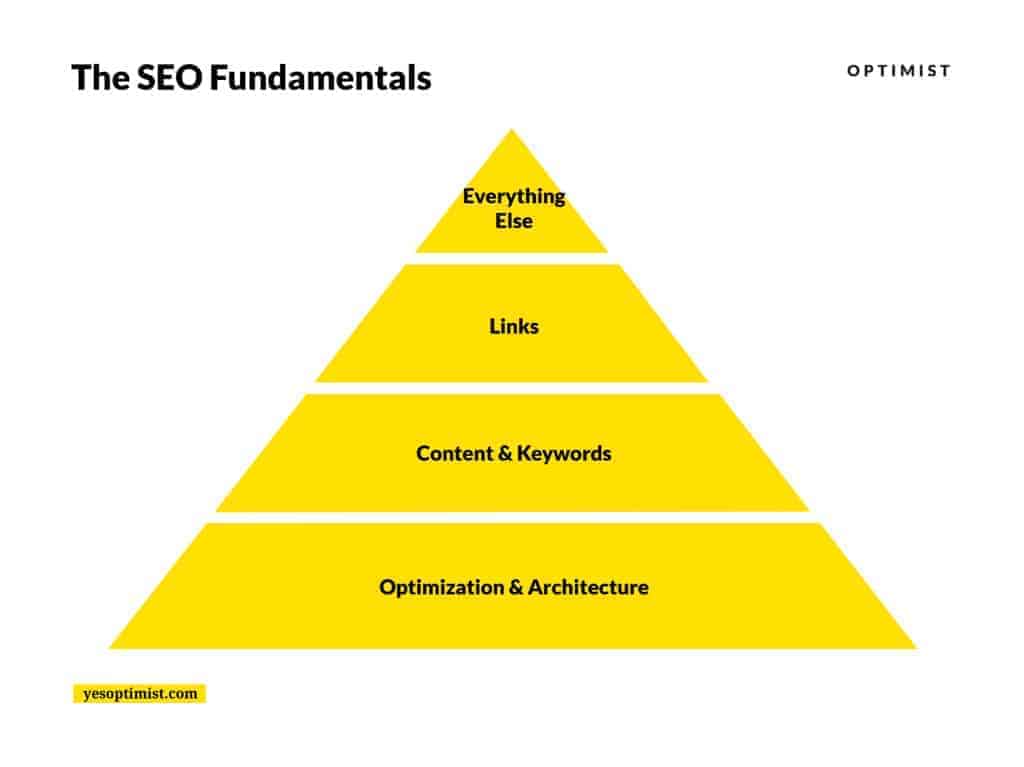
Without going into all of the gory details about linkbuilding strategy, I can boil our approach down into the two most basic steps:
- Create a kick-ass resource that other sites can use or reference
- Show it to the right people to earn links
For this client, we created several targeted linkable assets — infographics, data visualizations, and evergreen resources — that we used to secure placements and links back to the site.
While we had some big-name pickups in publications like Forbes, most of our link growth came through incremental wins. We shared content with other writers, bloggers, and marketers in the sales space to grow the site’s authority and scale traffic across all content and keywords.
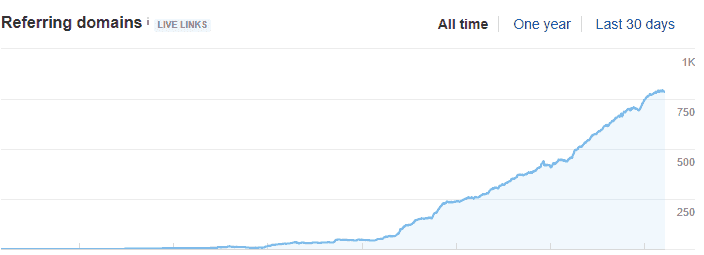
All told, we were able to grow the number of referring domains from about 45 to over 700 over the course of our engagement.
Building links was the hidden lever that drove traffic growth and scaled leads in an effective way.
This process can be both challenging and time-consuming. But it’s one of the most important (and commonly overlooked) elements of the strategy.
Accelerating SaaS Lead Generation with Paid Acquisition
In addition to our work on content and SEO, this client invested in a paid acquisition strategy to further scale lead generation.
Like most SaaS companies, their growth strategy included a mix of inbound, organic, paid, and outbound.
They found that their paid acquisition campaigns were especially effective when they built segmented retargeting on top of the content that we were creating. Essentially, they used paid to address the segmented buyers based on the content they’d previously read and then drive them toward the next step in our SaaS lead generation funnel.
This allowed them to:
- Scale lead generation beyond SEO and inbound traffic sources
- Build highly targeted and segmented lookalike audiences
- Retarget warm (brand aware) users with feature- and use-case-specific content and messaging
- Segment and target offers based on previous site activity
- Lower CPA versus acquisition campaigns targeting cold audiences
Completing the SaaS Lead Generation Framework
This strategy was effective for our client for five key reasons:
- We focused on leads as our core KPI rather than traffic.
- Our JTBD approach identified the key problems that the buyer is looking to solve, rather than focusing on the buyer’s characteristics.
- For each top-of-the-funnel keyword, we built a tailored funnel strategy to guide each reader through a semi-personalized buyer journey.
- After expanding the top-of-funnel strategy to capture as much targeted, relevant traffic as possible, we moved to middle- and bottom-of-the-funnel keywords to target higher-intent buyers.
- Throughout the entire process, we focused on growing the site’s domain authority by building high-quality links through content-driven outreach.
When we bring it all together, the framework looks something like this:
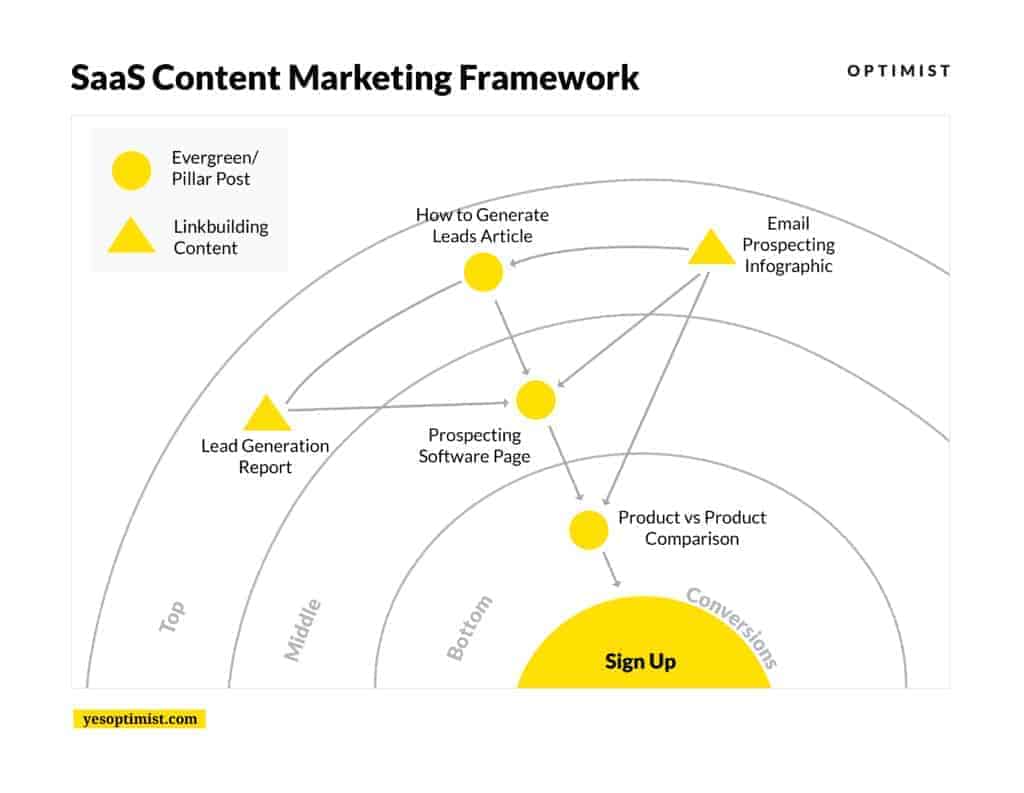
The bottom line is that SaaS companies need a holistic strategy to drive leads.
Simply publishing one kind of content isn’t enough to move the needle. And if you’re looking to invest time, resources, and money into creating content, then you should make sure that investment is sound.
You can safeguard your investment and maximize ROI by building a rock-solid strategy that leverages your content, fuels growth, and drives the numbers that matter.
Hiring a Content Marketing Agency to Help Scale SaaS Lead Generation
There are a lot of content marketing agencies out there.
And I can’t say that Optimist is the best SaaS content marketing agency for every single company.
But I can say that we’ve honed the craft of building scalable, growth-focused content marketing and lead gen strategies for SaaS companies.
Over the last 5 years, we’ve worked with dozens of SaaS companies in nearly every vertical and industry imaginable, We’ve learned a few important lessons about what matters most when building a successful strategy, creating effective content, and measuring the impact of our work together.
There are some things that we do, which I think set us apart from other SaaS content marketing agencies.
1. Focus on business metrics that matter
We are a strategic partner with our clients. We’re not a content production team brought in to crank out content or a content mill that sells blog posts by the pound.
We begin every engagement by trying to fully understand the business implications of content marketing and SEO, the metrics that matter to the company, and what KPIs we need to define in order to make data-driven decisions about our work together.
This means we aren’t myopically focused on vanity metrics like traffic or output metrics like the number of articles published.
We’re focused on revenue, sales, and leads — the numbers that truly matter to your SaaS business.
Let’s Talk About Growing Your SaaS Lead Generation
Book a strategy call with our team to discuss how we can help you hit your growth goals.
2. Deep strategic content marketing expertise
Our team has decades of combined experience building and executing content marketing strategies for all kinds of companies, including many SaaS and technology businesses.
We understand content marketing at a strategic level.
More importantly, we understand that “content” is not a monolith. Effective content marketing and SaaS lead generation strategies contain a combination of purpose-built assets that work together to achieve a specific content marketing goal.
Everything we create is built to accomplish a specific goal.
And everything we create works together to achieve the overall business goals.
3. SaaS lead generation and funnel expertise
Lastly, our team understands the buyer’s journey. We understand how SaaS buyers think, question, and act when evaluating and purchasing software.
We know that successful SaaS content marketing comes from a place of understanding the buyer, their pain points, and how the product can best serve their specific needs.
Our process is focused on translating those needs — and that journey — into a clearly defined strategy that reaches the right buyers at each stage in the funnel, drives them to take action, and converts them into leads, sales, and revenue.
There’s no point in chasing keywords that drive traffic but don’t convert. We’re not interested in vanity metrics or fake case studies that look great but didn’t move the needle.
Optimist is a growth-focused content marketing agency for SaaS companies.
We’re here to deliver growth for our clients.
Otherwise, what’s the point?
Get more kick-ass content from us
Subscribe to our email list and get regular updates.
No spam or BS. Just great, insightful articles.